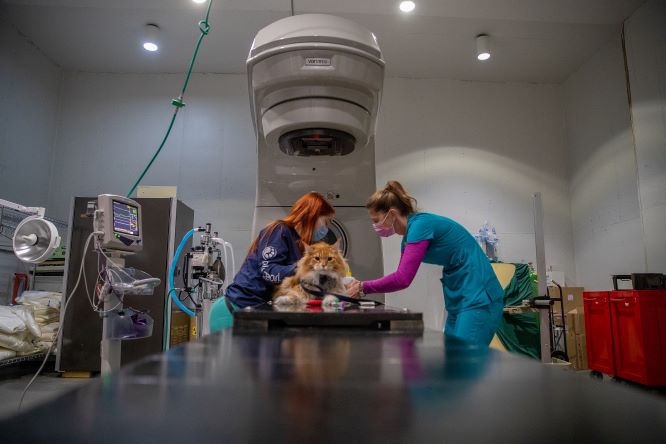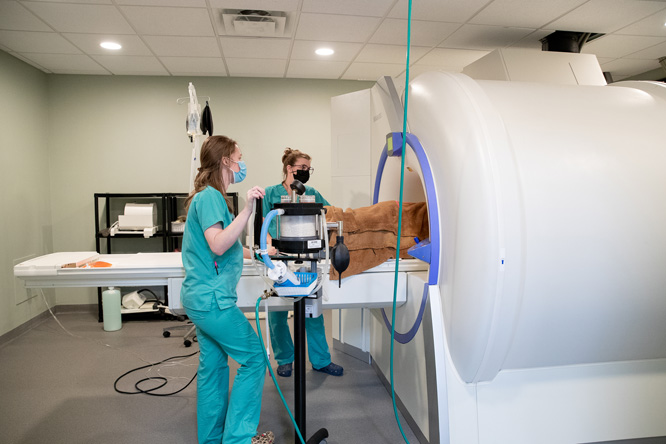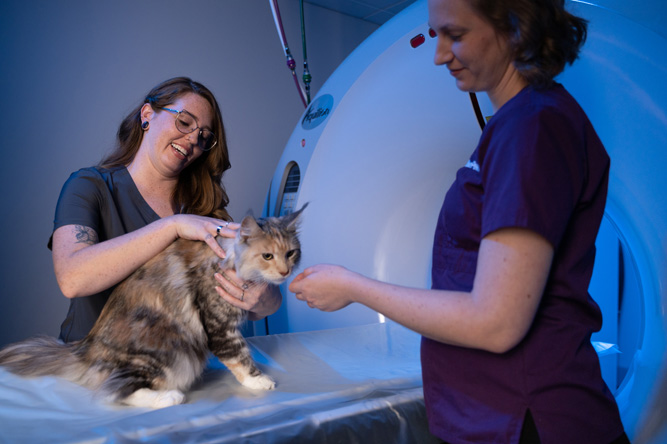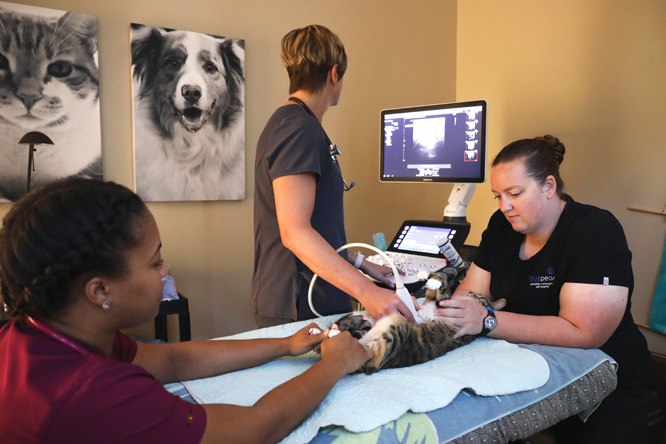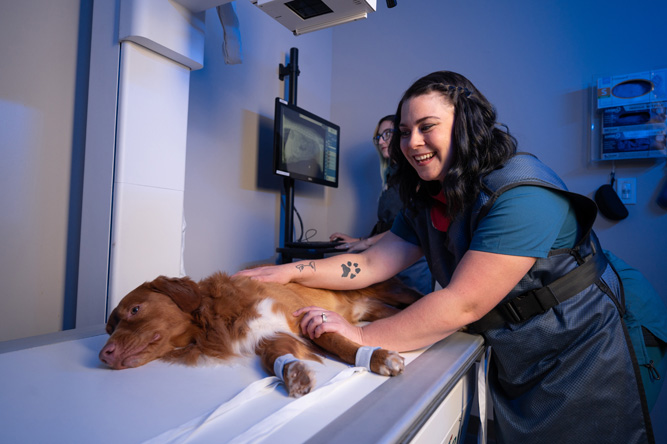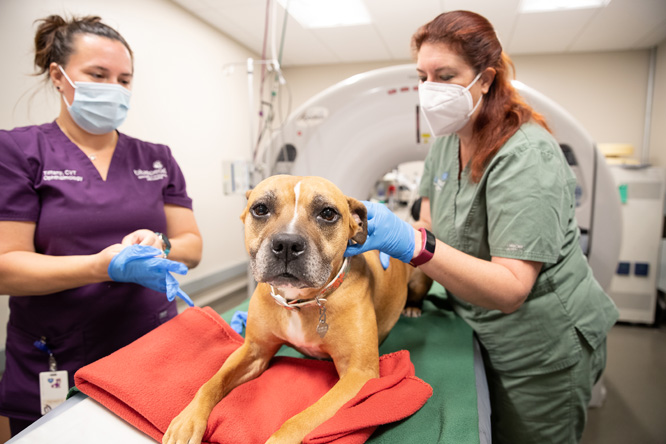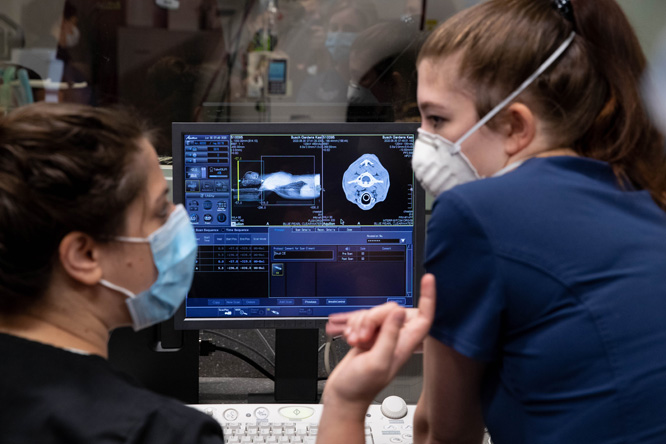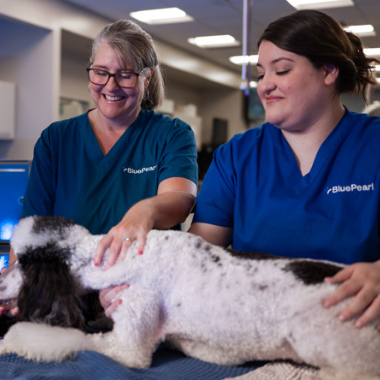Pet diagnostic imaging by BluePearl.
We understand that seeing your pet experience unusual symptoms or act out of the ordinary can be stressful – especially if you don’t know what’s wrong. Fortunately, our veterinary diagnostic imaging team is made up of experts in using state-of-the-art imaging equipment to reveal the source of the problem, and we’re here to help.
Our commitment is not just to diagnose illnesses; it’s to enhance the well-being of your pet and be with you every step of the way.
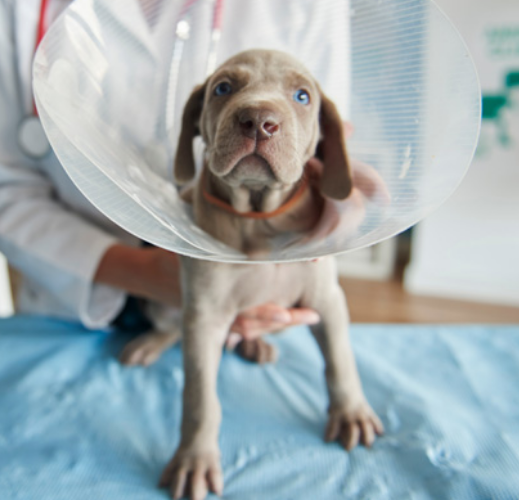
Services we offer.
Your pet will receive unparalleled medical care during their time at the hospital (and they’ll be spoiled with love and attention, too).
Advanced diagnostics
Your pet can’t tell us what’s wrong, so we use sophisticated diagnostics and imaging tools to uncover the source of the problem.
- Radiography (x-rays)
- CT scans (computerized tomography)
- MRI (magnetic resonance imaging)
- Real-time x-ray (fluoroscopy)
- Ultrasound
- Contrast radiology studies
Treatment plans
Just as no two patients are the same, neither are their treatment plans. Our diagnostic imaging team delivers key diagnostic information to other specialists and your primary vet so they can develop the most effective treatment plan to get your pet on the path to wellness.
Our board certified specialists and diagnostic imaging team.
Experience makes all the difference.
Our diagnostic imaging team is made up of veterinarians, vet technicians and assistants, and support staff with rigorous training and experience in specialty medicine. The team works hand in hand to provide the comprehensive, compassionate care your pet needs and deserves. Because we’re a multidisciplinary hospital, the team can consult the expertise of other specialty departments, too.
Frances Hinkle
DVM, DACVR, DACVR-EDIA dedicated clinician, Dr. Frances Hinkle’s professional interests include musculoskeletal imaging, ultrasound and computed tomography (CT).
- Diplomate, American College of Veterinary Radiology-Equine Diagnostic Imaging
- Diplomate, American College of Veterinary Radiology
- Residency, Radiology, Colorado State University, Fort Collins
- Internship, Small Animal Medicine & Surgery, Veterinary Specialists and Emergency Services, Rochester, NY
- Internship, Equine Medicine & Surgery, Rood and Riddle Equine Hospital, Lexington KY
- Doctor of Veterinary Medicine, Texas A&M University, College Station
- Bachelor of Science, Biomedical Sciences, Texas A&M, College Station
When not at work, Dr. Hinkle enjoys hiking, exploring, cooking and spending time with her husband and dogs.
Stephanie Knapp
DVM, DACVRDr. Stephanie Knapp is passionate about making a positive impact in the lives of her patients and clients. She enjoys collaborating with her colleagues to find new and improved methods of figuring out the “puzzles” associated with each case. She promotes a low-stress experience for her patients by using hands-free radiology techniques to obtain diagnostic images when possible.
Prior to becoming a veterinary radiologist, Dr. Knapp worked as an emergency clinician and she still as an “ER spirit.” She likes using imaging to diagnose emergency conditions like foreign bodies and abscess. She finds cancer imaging particularly gratifying.
- Diplomate, American College of Veterinary Radiology
- Residency, Radiology, University of Missouri, Columbia
- Internship, Small Animal Medicine & Surgery, VCA Sacramento Veterinary Referral Center, CA
- Doctor of Veterinary Medicine, University of Missouri, Columbia
- Bachelor of Science, Biology, Truman State University, Kirksville MO
- Bachelor of Arts, Biology, Truman State University, Kirksville MO
Dr. Knapp and her husband enjoy outdoor activities and travel to beautiful places. She and her dog as interested in “canicross,” a sport involving cross-country running with dogs, on the local trails.
Maureen Levesque
VMD, DACVRAn experienced clinician, Dr. Maureen Levesque is especially interested in imaging the musculoskeletal system. She also finds participating in emergency cases to be extremely gratifying.
- Diplomate, American College of Veterinary Radiology
- Residency, Radiology, Tufts Cummings School of Veterinary Medicine, Grafton MA
- Internship, Small Animal Medicine & Surgery, Alamo Pintado Equine Medical Center, Los Olivos CA
- Doctor of Veterinary Medicine, University of Pennsylvania, Philadelphia
- Bachelor of Science, Biology, University of Illinois, Urbana-Champagne
When not working, Dr. Levesque enjoys reading, hiking, and spending time with her young son. She shares her home with two scruffy dogs and two kitties.
What to expect.
We want you to be prepared for your pet’s visit to the radiologist, so you have one less thing to worry about. Our entire BluePearl team will be with you every step of the way.
Before your visit
- You can make an initial appointment by calling us directly or via referral from your pet’s primary or specialty vet.
- We’ll get records from your primary or specialty vet before your first visit and collaborate with them to discuss your pet’s history and current condition.
- Special preparation, such as fasting or medication, may be required before your pet’s imaging appointment. Our team will inform you how to prepare and answer any questions about the procedure.
During your visit
- Most diagnostic tests rely on patients being still. To make things easier and more comfortable for your pet, we usually use sedation or anesthesia, which also helps avoid the need for repeat imaging.
- Once your pet’s procedure is complete, our team will review the images and consult with your pet’s care team.
- You’ll have plenty of time and opportunity to ask questions as a doctor goes over your pet’s results, diagnosis and treatment options.
After your visit
- Our team will ensure that your pet’s continuity of care continues by sharing imaging results with your pet’s primary or specialty veterinarian.
- If further testing is required, especially for monitoring treatment progress, your primary veterinarian or specialist may order additional imaging studies.
- You know your pet better than anyone, and you play a crucial role in their treatment plan. If you have any questions or concerns about their diagnostic imaging experience, let us know – we’re here for you.
